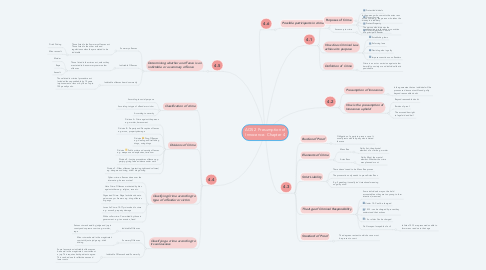
1. 4.4
1.1. Classification of crime
1.1.1. According to social purpose
1.1.2. According to type of offender or victim
1.1.3. According to severity
1.2. Divisions of Crime
1.2.1. Division A: Crime against the person e.g. murder, harassment
1.2.2. Division B: Property and Deception offences e.g. arson, property damage
1.2.3. Division C: Drug Offences e.g. dealing and trafficking drugs, using drugs
1.2.4. Division D: Public order and security offences e.g. weapons and explosives, terrorism
1.2.5. Division E: Justice procedures offences e.g. perjury- giving false evidence under oath
1.2.6. Division F: Other offences (protecting rights and cultures) e.g. dangerous driving, drink/ drug driving
1.3. Classifying Crime according to type of offender or victim
1.3.1. Cyber- crime: offences done over the internet e.g. harass or steal
1.3.2. Hate Crime: Offences motivated by bias against others e.g. religion, race etc.
1.3.3. Organised Crime: Illegal activities done to gain money or firearms e.g. drug offences or gangs
1.3.4. Juvenile Crime: 10-17yrs involved in crime e.g. assault, property damage
1.3.5. White collar crime: Committed by those in government. e.g. tax evasion, fraud
1.4. Classifying a crime according to its seriousness
1.4.1. Indictable Offences
1.4.1.1. Serious crimes heard by judge and jury in county and supreme courts e.g. murder, rape
1.4.2. Summary Offences
1.4.2.1. Minor crimes heard in the magistrates' court with just a judge e.g. drink driving
1.4.3. Indictable Offences heard Summarily
1.4.3.1. Some less serious indictable offences can be heard in the magistrates' court without a jury. This requires both parties to agree. This can be done for effectiveness and lower costs
2. 4.5
2.1. Determining whether an offence is an indictable or a summary offence
2.1.1. Summary offences
2.1.1.1. Those listed in the Summary offences act. Those listed in the other acts and regulations unless they are stated to be indictable
2.1.1.1.1. Drink Driving
2.1.1.1.2. Minor assault
2.1.2. Indictable Offences
2.1.2.1. Those listed in the crimes act, unless they are stated to be summary common law offences
2.1.2.1.1. Murder
2.1.2.1.2. Rape
2.1.2.1.3. Assault
2.1.3. Indictable offences heard summarily
2.1.3.1. Those listed in criminal procedure act. Included those punishable by 10 years imprisonment or less or by fine of up to 120 penalty units.
3. 4.6
3.1. Possible participants in crime
3.1.1. Principal Offender
3.1.1.1. Is the person who commits the actus reus of the crime e.g. the person who takes the money in a robbery
3.1.2. Accessory to crime
3.1.2.1. The person who impedes the apprehension, prosecution or conviction of a principal offender
4. 4.1
4.1. Purposes of Crime
4.1.1. Protect Individuals
4.1.2. Protect Society
4.1.3. Protect Property
4.1.4. Protect Rights and Culture
4.2. How does Criminal Law achieve its purpose
4.2.1. Establishing laws
4.2.2. Enforcing laws
4.2.3. Deciding who is guilty
4.2.4. Imposes sanctions on offenders
4.3. Definition of Crime
4.3.1. Crime is an act or omission against a law harmful to society or and individual that is punishable
5. 4.2
5.1. Presumption of Innocence
5.1.1. Is the guarantee that an individual will be pronounced innocent until found guilty beyond reasonable doubt
5.2. How is the presumption of Innocence upheld
5.2.1. Beyond reasonable doubt
5.2.2. Burden of proof
5.2.3. The accused has right to legal aid and bail
6. 4.3
6.1. Burden of Proof
6.1.1. Obligation of a party to prove a case. It usually rests with the party who initiated the case
6.2. Elements of Crime
6.2.1. Mens Rea
6.2.1.1. Guilty Act- the physical element of a crime e.g murder
6.2.2. Actus Reus
6.2.2.1. Guilty Mind- the mental element. Whether the crime was planned or not
6.3. Strict Liability
6.3.1. There doesn't need to be Mens Rea proven
6.3.2. The prosecution only needs to prove Actus Reus
6.3.3. E.g. Speeding- it usually isn't intentional meaning no guilty mind
6.4. The Age of Criminal Responsibility
6.4.1. Some individuals may not be held accountable as they are too young to form intention (mens rea)
6.4.2. Under 10- Can't be charged
6.4.3. 10-13- can be charged if proven they understood their actions
6.4.4. 14 or older- Can be charged
6.4.5. Doli Incapax- Incapable of evil.
6.4.5.1. children 10-13 are presumed unable to form mens rea due to their age
6.5. Standard of Proof
6.5.1. The degree or extent to which a case must be proven to court
